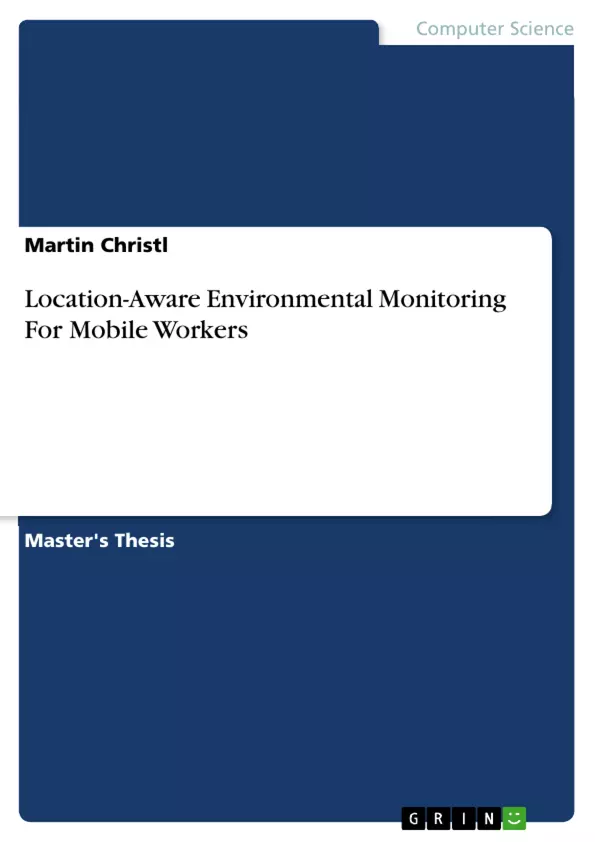The aim of this master’s thesis ist to investigate the practicability and usability of mobile GIS applications in a selected real-world scenario in the field. Therefore the important questions are how to provide correct geospatial positioning values and how to support the gathering of useful data in extreme field situations by implementing a mobile GIS prototype. The whole project discussed in this thesis was initiated by the “Institute of Distributed and Multimedia Systems” (Faculty of Computer Sciences) through the “Austrian GRID” initiative in a close collaboration with the Umweltbundesamt, the “Federal Environment Agency of Austria”. An environmental observation area in the national park “Northern Calcareous Alps” in Upper Austria, called „Zöbelboden“ was chosen to test the accuracy of GPS signals and according positioning data in forested or mountainous areas as well as to study the advantages
and benefits of using mobile devices in outdoor situations and free nature. This area, a part of the UN ECE’s Integrated Monitoring Programme, is used for long-term environmental data in selected observation areas. Exactly this project is a multidisciplinary International Cooperative Programme (ICP) on Integrated Monitoring (IM) of Air Pollution Effects on Ecosystems, which covers regions of the United Nations Economic Commission for Europe (UN ECE).
In this master thesis a prototype will be introduced which allows capturing the desired ecological data digitally using a personal digital assistant (PDA). An easy-to-use application based on ESRI’s ArcPad Application Developer has been developed for use on Windows Mobile PocketPCs which integrates the Umweltbundesamt’s own ESRI data layers. Thus, the mobile device is prepared for data integration into a data GRID infrastructure of the Umweltbundesamt. This new prototype is a GPS-assisted client, which enables location-awareness and further allows mobile users to augment the collected data with comments, digital photos, digital audio, or even small movies
of artifacts, like trees and other plants. All digitally collected data by the mobile workers can be easily transferred to the Umweltbundesamt’s currently used ecological information system MORIS (a relational database).
Inhaltsverzeichnis (Table of Contents)
- Abstract
- Danksagungen (Acknowledgments)
- 1. Introduction
- 1.1 Background
- 1.2 Motivation
- 1.3 Scope and Objectives
- 2. Related Work
- 2.1 Mobile GIS Systems
- 2.2 Location-Awareness in Field Studies
- 2.3 Environmental Monitoring
- 3. Methodology
- 3.1 Research Approach
- 3.2 System Design and Implementation
- 4. Implementation
- 4.1 Hardware and Software Environment
- 4.2 Prototype Development
- 4.3 System Architecture
- 4.4 Data Integration
- 5. Field Tests and Evaluation
- 5.1 Test Site and Data Collection
- 5.2 Data Analysis and Results
- 6. Discussion and Conclusion
- 6.1 Achievements and Limitations
- 6.2 Future Directions
- Bibliography
Zielsetzung und Themenschwerpunkte (Objectives and Key Themes)
The master’s thesis investigates the feasibility and usability of mobile GIS applications in real-world environmental monitoring scenarios. The project aims to develop a prototype mobile GIS system for collecting ecological data in challenging outdoor environments. This involves exploring the challenges of accurate geospatial positioning and facilitating efficient data collection in extreme field situations.
- Mobile GIS for Environmental Monitoring
- Location-Awareness in Field Studies
- Data Collection and Integration in Outdoor Environments
- Prototype Development and Implementation
- Field Testing and Evaluation
Zusammenfassung der Kapitel (Chapter Summaries)
The thesis begins by introducing the background, motivation, and objectives of the research. Chapter 2 presents a comprehensive review of related work in the areas of mobile GIS systems, location-awareness in field studies, and environmental monitoring. Chapter 3 outlines the research approach and the system design and implementation process. Chapter 4 delves into the details of the prototype development, including the hardware and software environment, system architecture, and data integration strategies. Chapter 5 describes the field tests conducted at the Zöbelboden observation site, focusing on data collection and analysis. The thesis concludes with a discussion of achievements, limitations, and potential future directions.
Schlüsselwörter (Keywords)
Mobile GIS, environmental monitoring, location-awareness, data collection, prototype development, field testing, data integration, ecological data, GPS, PDA, ArcPad, MORIS.
- Quote paper
- Mag. rer. soc. oek. Martin Christl (Author), 2008, Location-Aware Environmental Monitoring For Mobile Workers, Munich, GRIN Verlag, https://www.grin.com/document/121322



